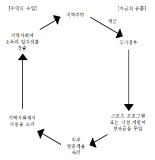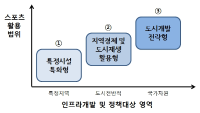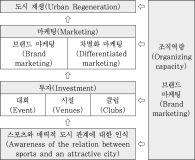
Purpose The purpose of this study is to identify the causal relationship between competitive strategy, absorption capacity and business performance of commercial fitness center and to confirm the control effect of absorption capacity between competitive strategy and business performance. Methods 330 fitness center managers and administrators were selected for the study. Out of 330, 308 questionnaires were collected and used for data analysis. The questionnaire consisted of confirmatory factor analysis, reliability analysis, correlation analysis and structural equation model analysis. Finally, Ping 's two - step approach was used to verify the moderate effect of absorptive capacity. Results The results of the study are as follows. First, competition strategy of fitness center has a positive effect on absorptive capacity. Second, the competition strategy of fitness center has a significant effect on business performance. Third, the absorptive capacity did not effect the management performance. Fourth, the absorptive capacity was found to be moderate effect between the competition strategy and the management performance of the fitness center. Conclusion Based on the results, the fitness center managers and administrators of fitness center should set up competitive strategy internally and increase absorptive capacity to utilize external information by internalizing it.


PURPOSE This study examined the effects of focus of attention on beginning golfers’ competitive anxiety and motor performance. METHODS Forty-eight college students with no prior golf putting experience were selected as participants and randomly assigned to internal-focus, external-focus, holistic-focus, and control groups (12 participants each). All subjects performed 5-m golf putting in acquisition, noncompetitive, and competitive situations. RESULTS In competitive situations, the internal-focus, holistic-focus, and control groups showed golf putting accuracy and consistency similar to those in noncompetitive situations, whereas the external-focus group’s golf putting accuracy and consistency were significantly lower in competitive situations than in noncompetitive situations. In addition, the holistic-focus group showed significantly higher golf putting accuracy than the control group in both competitive and noncompetitive situations. CONCLUSIONS Holistic-focus can be used effectively as a strategy for beginners to learn motor skills and reproduce learned motor skills when state anxiety increases. However, external attention focus cannot be considered a strategy to induce effective beginners’ exercise performance when competitive state anxiety increases.
PURPOSE This study comprehensively compared the perception and interaction of player–coach in the development of mental toughness in soccer. METHODS Data were collected through semi-structured individual interviews from 12 participants (6 athletes and 6 coaches), analyzed using the grounded theory by Strauss and Corbin, and they were compared to the group of athletes and coaches, respectively. RESULTS The following results were obtained: (1) Both athletes and coaches recognized that the experience of coping with the pressure present in competition was a central phenomenon in the development of mental toughness. (2) Regarding the situation and condition that lead to coping with pressure, the athletes emphasized the individual's goal orientation in the context of competitive situations and environmental conditions, while the coaches emphasized the athletic attitude toward competition and development in childhood. (3) The athlete–coach interaction was identified as an intervening condition affecting the experience of coping with pressure. (4) As the action–reaction strategy for the development of mental toughness, the optimistic thinking was emphasized for athlete and achievement-oriented thinking for coach; thus, it differed in the characteristics of mental toughness. CONCLUSIONS This study presented the results of an integrated comparison of mental toughness, which can vary depending on the contextual specificity (soccer) and the subject of perception (athlete– coach), especially indicating the importance of the player–coach interaction, which can contribute to the strategy to be used in mental toughness development.
Purpose The purpose of this study was to examine athletes’ psychological competition experiences. Methods For this study, 64 student athletes, attending universities located in Seoul and Chungcheongbuk-do, participated in the study by completing an unconstructed questionnaire. The data were analysed through content analysis method. Results As a result, 15 themes, such as morale loss, comparable performance levels, opponent irritation were collected and the themes were classified into three categories including objectives of psychological competition, requirements of psychological competition, and psychological battle. In match situations, athletes attempt to psychologically compete in order to achieve objectives such as opponent’s morale loss, induce carelessness, trigger agitation and anger, dispersion of attention, and distraction. Psychological competition among rivals is valid when the requirements, such as comparable performance levels, sensitivity to match situations, strong tenacity and confidence, understanding of opponent and oneself, mutual checks and balances, are met. Athletes attack and defend to win the psychological competition by utilizing opponents irritation, information distortion, unexpected behaviors, predicting and coping, pulling a poker face, exclusion of opponents, and self-focusing. Conclusion This study created a theoretical foundation for a profound understanding of athletes’ psychological competition, which is often found in sport fields. Furthermore, this study is meaningful in that it has raised a chance of interest concerning psychological interaction between players in match situations.

A number of global cities and local cities facilitate local economies and development by utilizing sports. However, their strategy is likely to be a short-term and one-time policy, which does not continuously strengthen their development. Therefore, the use of sports needs to be considered as more specific and longer term strategies for local development. This study examines the concept and role of sports city focused on cases of overseas sports cities, and successful and ideal cases of background and features of sports cities were analyzed to promote and lead the direction of improvement of sports cities in Korea. Consequently, strengthening a city’s sport capability and connecting it to local development need to be met to become a city into a successful sport city. To do so, it should premise recognition that sports cannot be treated separately from other urban policy area and it needs to invest in sports facilities, hosting sports events and competitions, and sports clubs based on the recognition for the importance of sports. Moreover, it needs a marketing strategy for branding and differentiation through sports of a city’s expertise. Finally, to make sports act as a catalyst to strengthen the process of an integrated city’s competitiveness, it requires a local government’s strong leadership and organization capacity of stakeholders.









PURPOSE This study aimed to explore methods for stimulating consumer purchasing behavior in the sportswear market, where gaining a competitive edge through traditional means has become increasingly challenging, by focusing on the recently highlighted environmental, social, and governance (ESG) management practices. The objective was to present strategic alternatives for sportswear brands grounded in sustainable management and value creation. METHODS The research employed SPSS 21.0 and AMOS 21.0 for frequency analysis, reliability and validity analysis, confirmatory factor analysis, structural equation modeling, and mediation effect analysis. RESULTS First, among the sportswear brand‘s ESG message trust and ESG authenticity, only ESG authenticity positively impacted consumer behavior. Second, both the sportswear brand‘s ESG message trust and ESG authenticity were found to positively influence ESG congruence. Third, ESG message trust and ESG authenticity negatively affected ESG skepticism. Fourth, ESG congruence positively impacted consumer behavior. Fifth, ESG skepticism was found to negatively influence consumer behavior. The mediation effect analysis yielded the following results: First, the direct effect of ESG message trust on consumer behavior was not statistically significant; however, a full mediation effect was observed through ESG congruence and skepticism. Second, the direct effect of ESG authenticity on consumer behavior was statistically significant, with a partial mediation effect through ESG congruence and skepticism. CONCLUSIONS For sportswear brands to achieve sustainable management and profit generation, it is essential to explore methods for stimulating consumer purchasing behavior based on trust and authenticity in ESG messages.
PURPOSE Sporting events constitute attractive platforms for providing participants with unique experiences. This study was aimed at investigating the structural relationships among perceived sporting event quality, image, trust, satisfaction, and loyalty of small-scale golf tournament participants. METHODS The questionnaire was structured in five dimensions: sporting event quality (4 sub-dimensions and 13 items), image (3 items), trust (3 items), satisfaction (3 items), and loyalty (4 items). A total of 217 amateur golfers from four Ecolian public golf clubs (Gwangsan, Jechon, Jeoungsun, and Younggwang) during the golf tournament participated in this study. Factor, reliability, validity, and structural equation model analyses were performed utilizing SPSS 24.0 and AMOS 24.0. RESULTS This study indicated that sporting event quality in a small-scale sporting event was the crucial factor of image, trust, and satisfaction, which, in turn, significantly impacted loyalty. CONCLUSIONS The results of this study contribute to theoretical understandings of sporting event quality factors that predict sport consumers’ image, trust, and satisfaction in the context of sports and leisure. Additionally, this study offers practical suggestions for administrators who develop marketing strategies for small-scale sporting events.